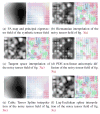Robust Tensor Splines for Approximation of Diffusion Tensor MRI Data
- PMID: 20454465
- PMCID: PMC2865691
- DOI: 10.1109/CVPRW.2006.179
Robust Tensor Splines for Approximation of Diffusion Tensor MRI Data
Abstract
In this paper, we present a novel and robust spline approximation algorithm given a noisy symmetric positive definite (SPD) tensor field. Such tensor fields commonly arise in the field of Medical Imaging in the form of Diffusion Tensor (DT) MRI data sets. We develop a statistically robust algorithm for constructing a tensor product of B-splines - for approximating and interpolating these data - using the Riemannian metric of the manifold of SPD tensors. Our method involves a two step procedure wherein the first step uses Riemannian distances in order to evaluate a tensor spline by computing a weighted intrinsic average of diffusion tensors and the second step involves minimization of the Riemannian distance between the evaluated spline curve and the given data. These two steps are alternated to achieve the desired tensor spline approximation to the given tensor field. We present comparisons of our algorithm with four existing methods of tensor interpolation applied to DT-MRI data from fixed heart slices of a rabbit, and show significantly improved results in the presence of noise and outliers. We also present validation results for our algorithm using synthetically generated noisy tensor field data with outliers. This interpolation work has many applications e.g., in DT-MRI registration, in DT-MRI Atlas construction etc. This research was in part funded by the NIH ROI NS42075 and the Department of Radiology, University of Florida.
Figures






References
-
- Arsigny V, Fillard P, Pennec X, Ayache N. Fast and Simple Calculus on Tensors in the Log-Euclidean Framework. Proceedings of MICCAI, LNCS. 2005:259–267. - PubMed
-
- Basser P, Mattiello J, Lebihan D. Estimation of the Effective Self-Diffusion Tensor from the NMR Spin Echo. J Magn Reson B. 1994;103:247–254. - PubMed
-
- Fillard P, Arsigny V, Pennec X, Thompson P, Ayache N. Extrapolation of sparse tensor fields: Application to the modeling of brain variability. IPMI. 2005:27–38. - PubMed
-
- Fletcher P, Joshi S. Principal geodesic analysis on symmetric spaces: Statistics of diffusion tensors. Proc of CVAMIA. 2004:87–98.
-
- Helgason S. Differential geometry, Lie groups, and symmetric spaces. American Mathematical Society; 2001.
Grants and funding
LinkOut - more resources
Full Text Sources
